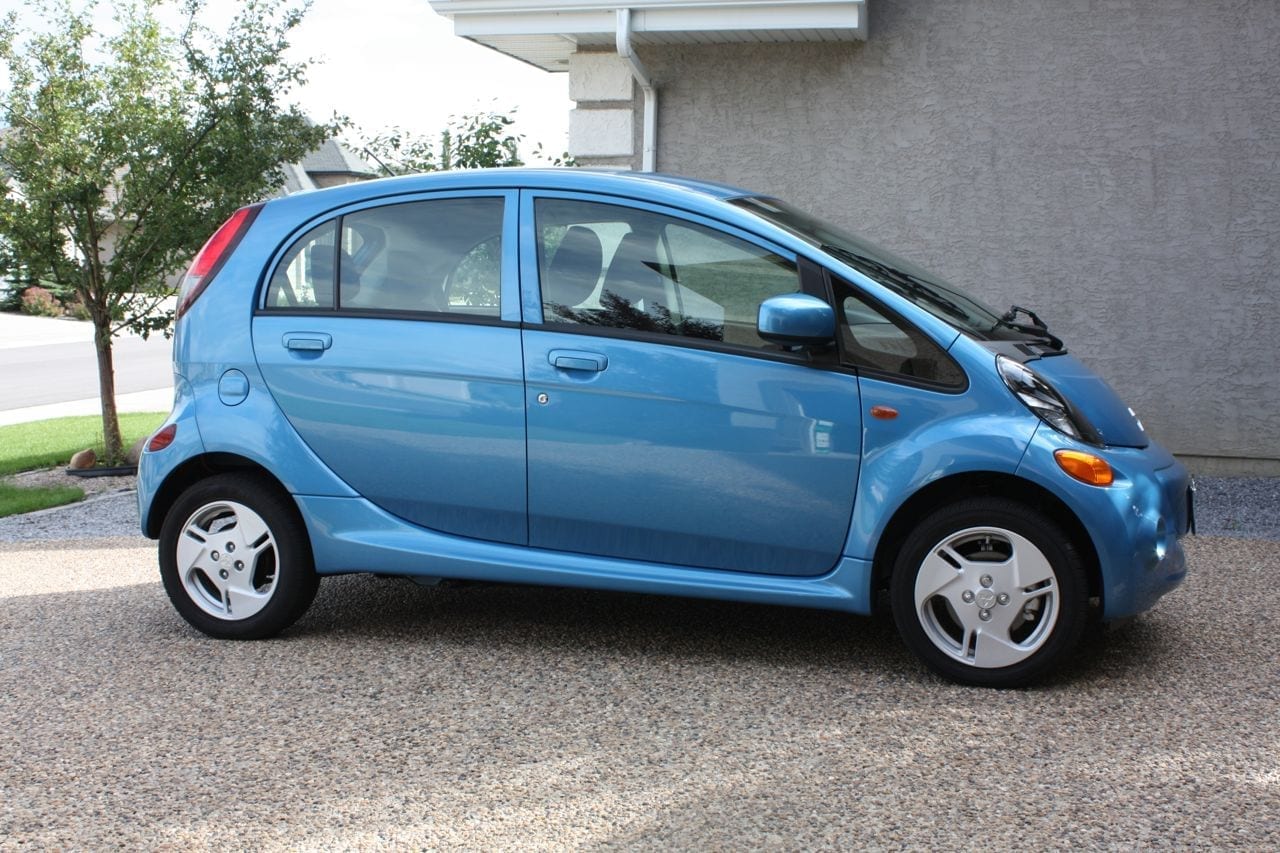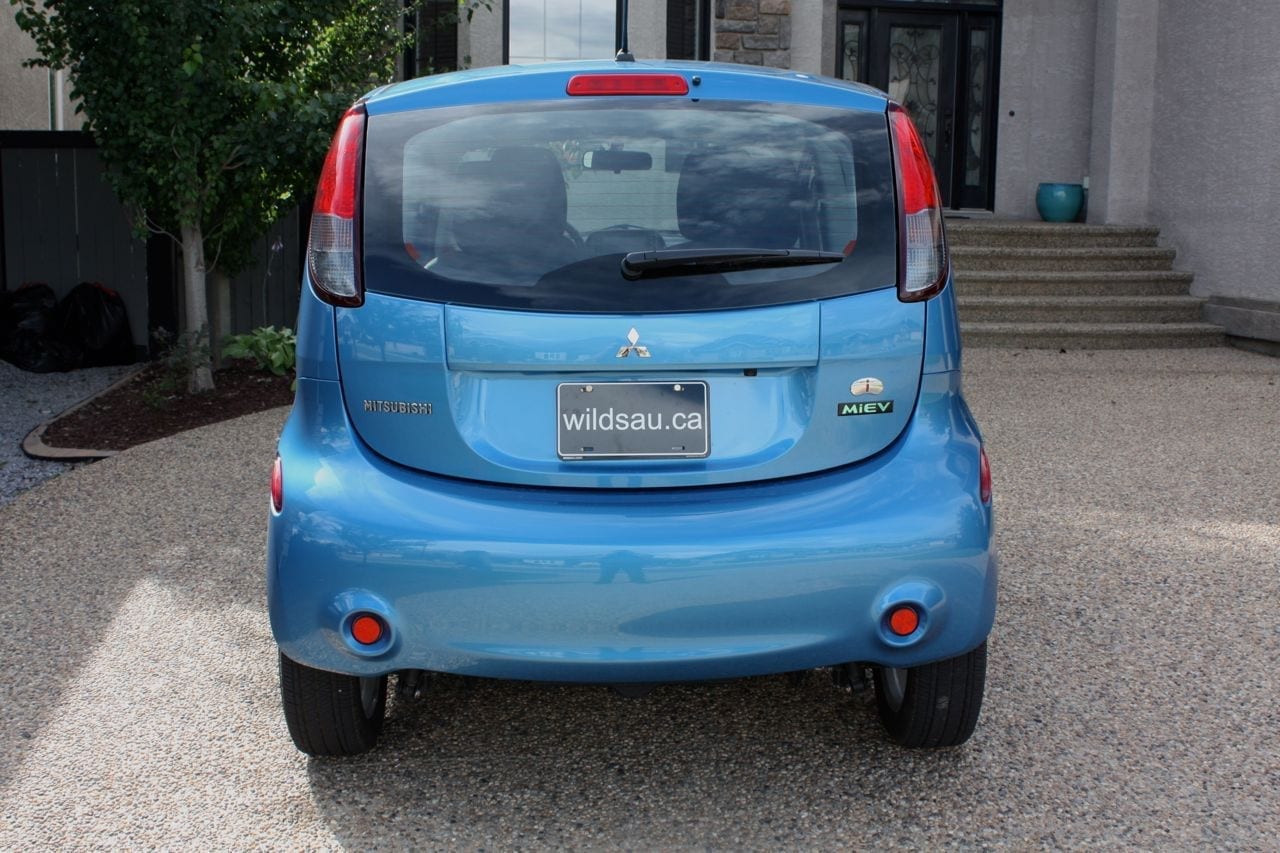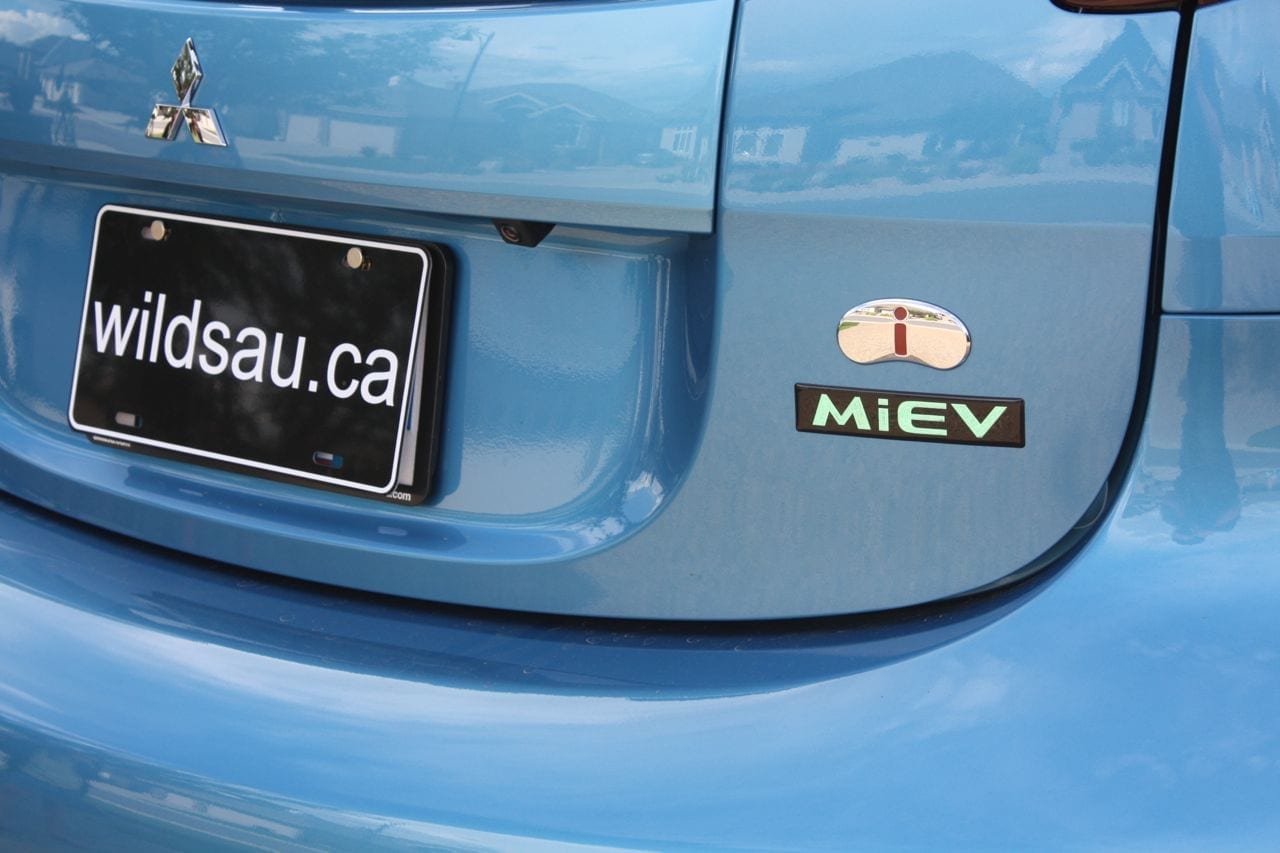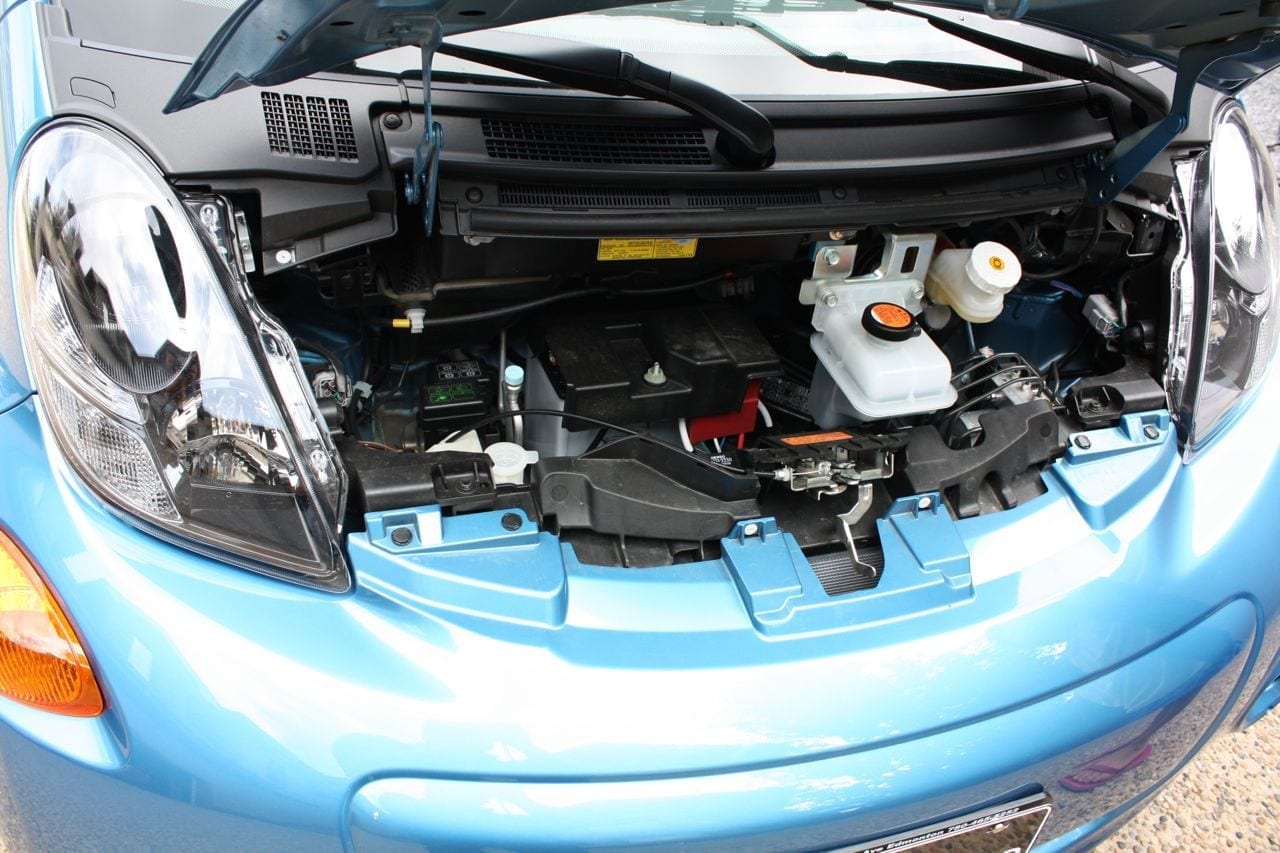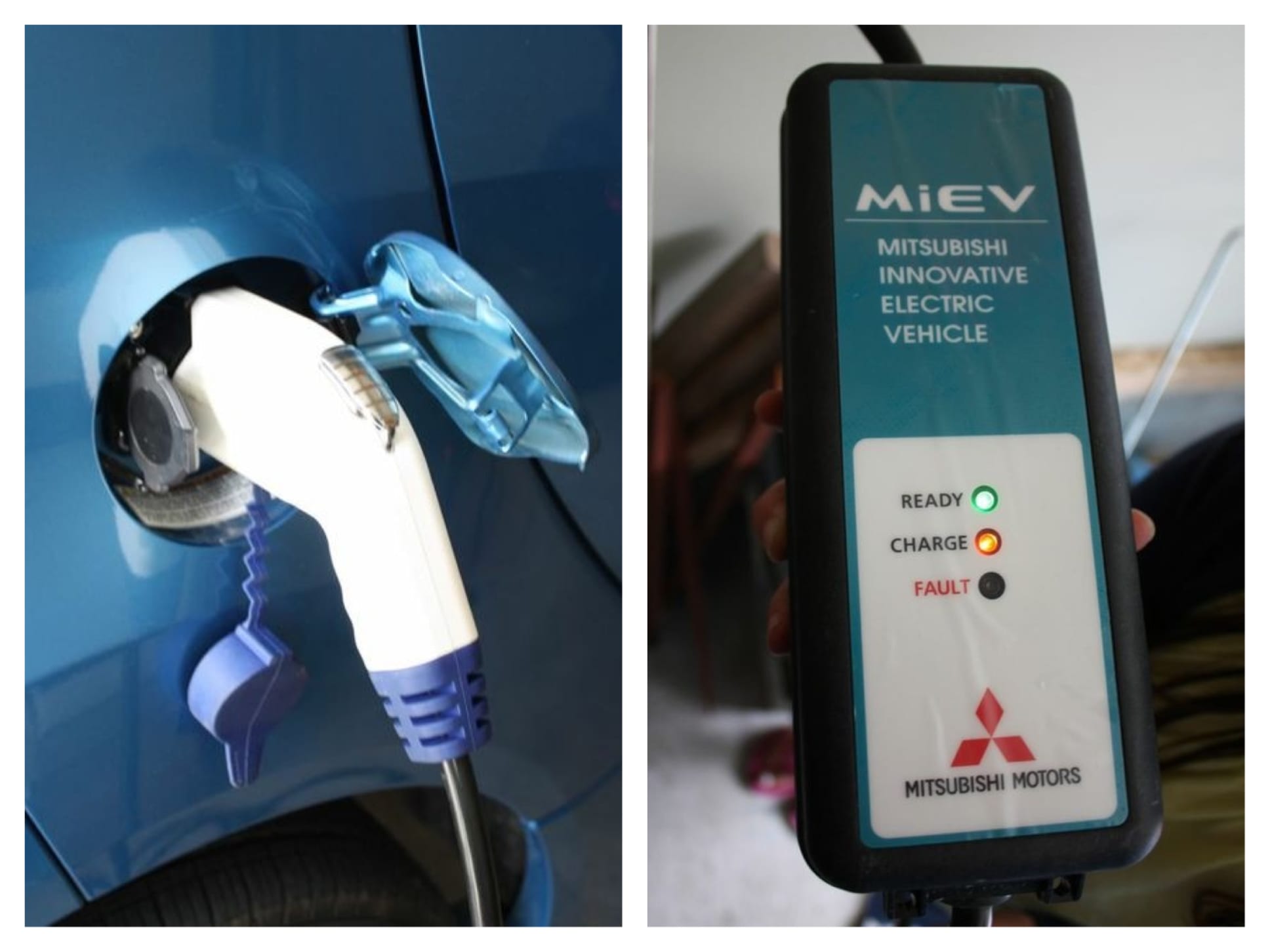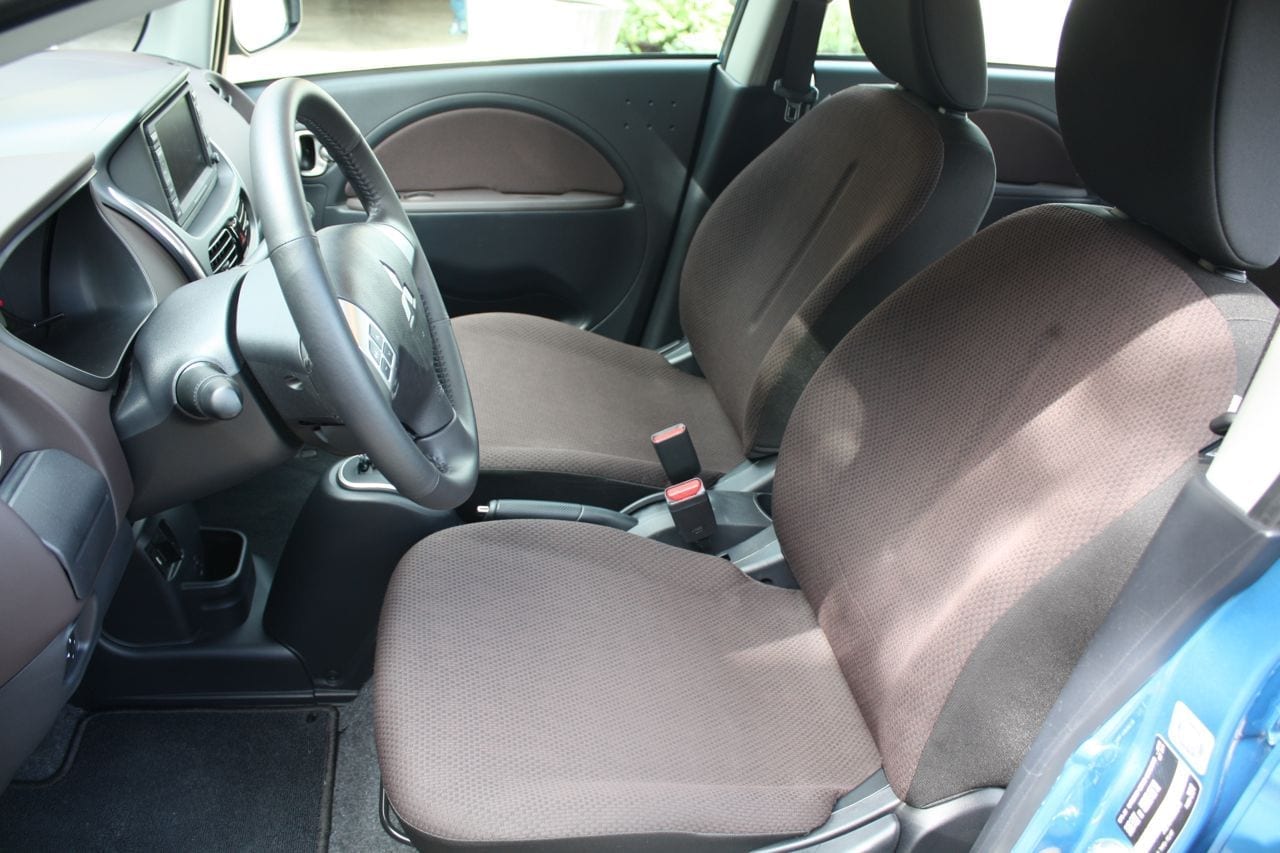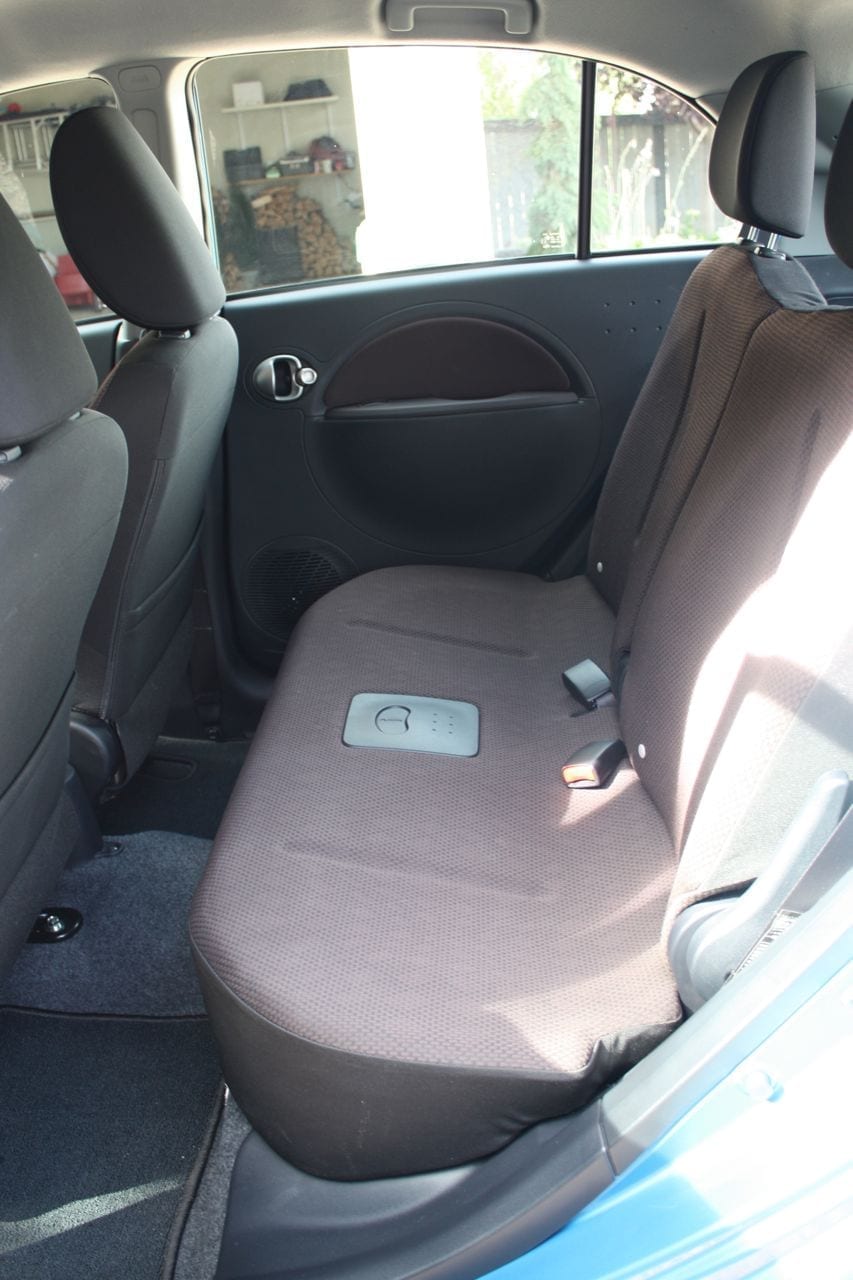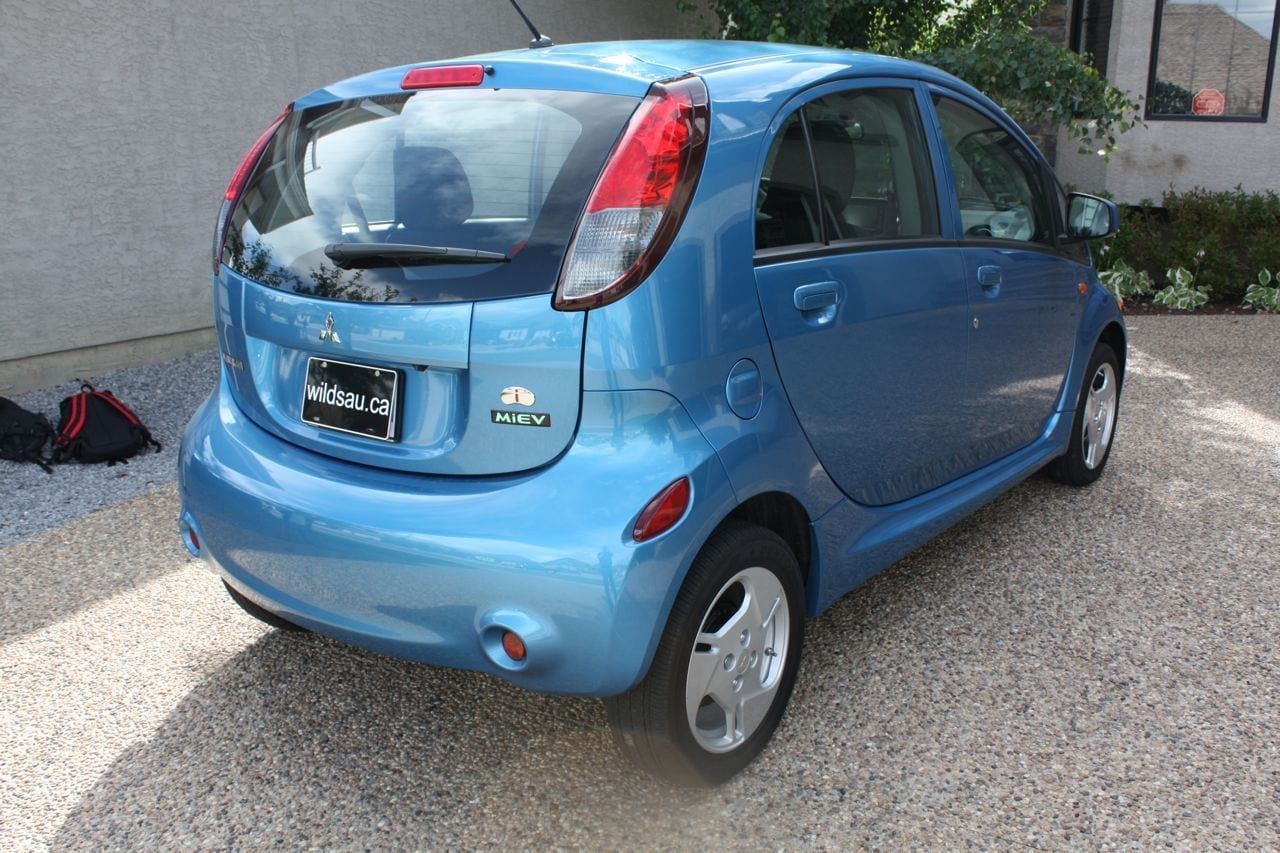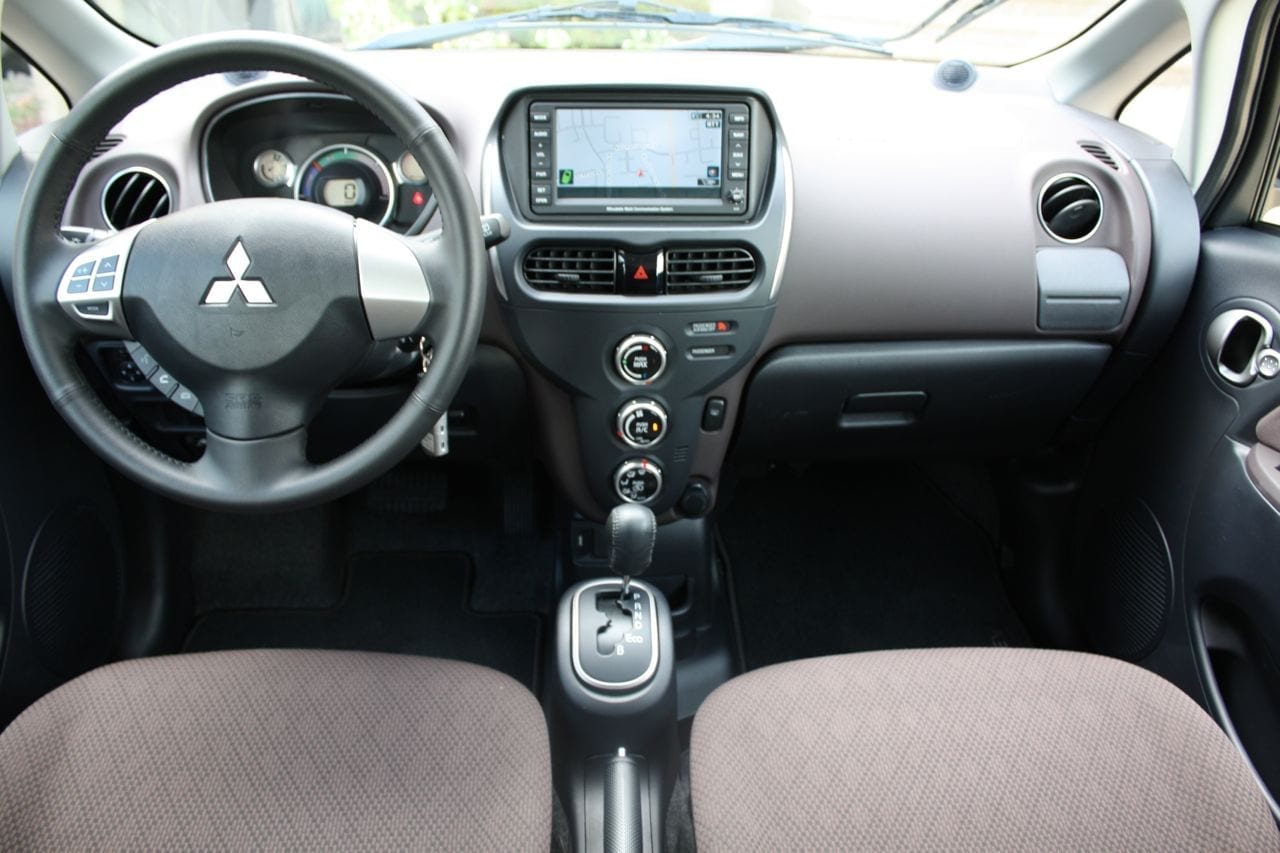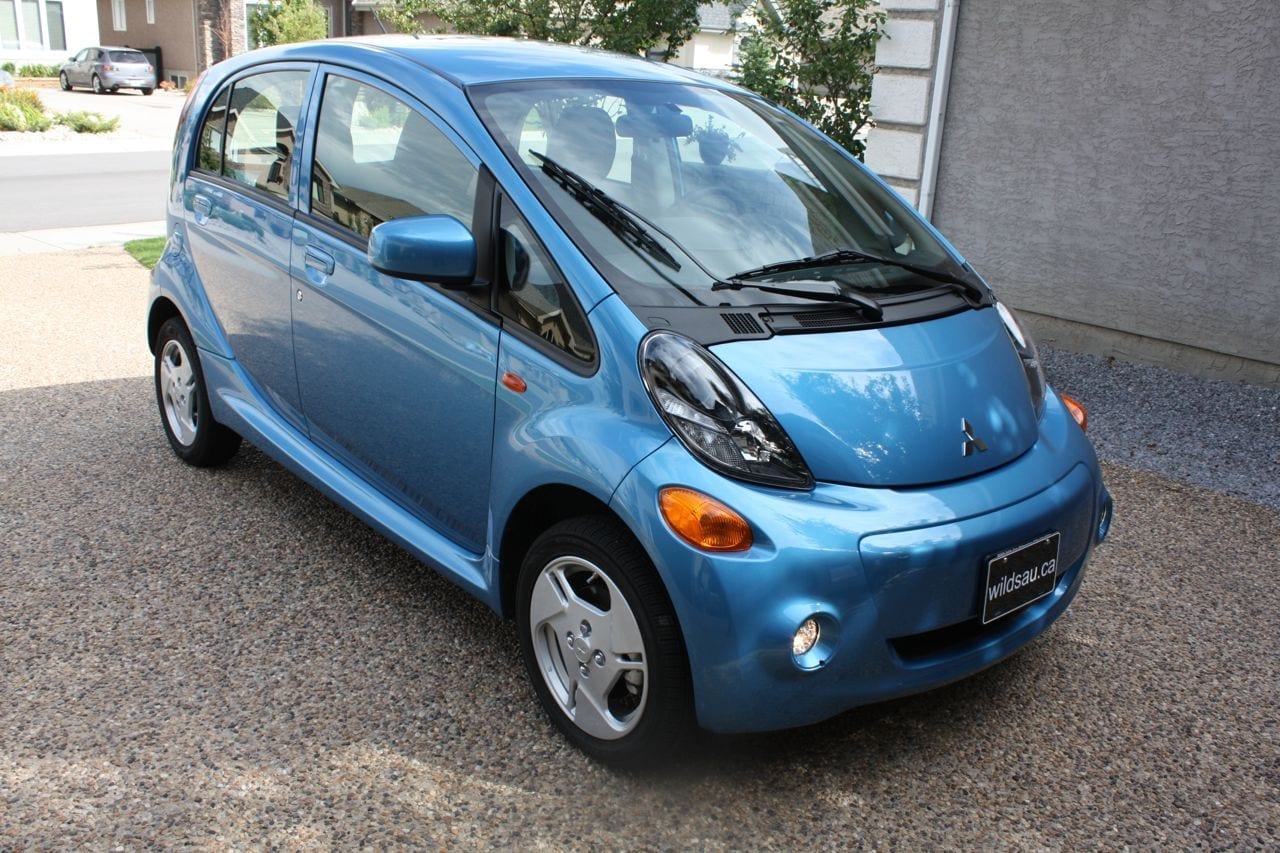First things first – let’s get the pronunciation out of the way. It’s pronounced EYE-meev. And EV means Electric Vehicle. OK? OK.
So I got to spend some time with this relatively new vehicle – it’s Mitsubishi’s new-to-North-America i-MiEV. This vehicle has actually been around since 2009 in Japan, but it’s new to us and has been available since December 2011.
The i-MiEV starts at CDN $32,998. There are only two trim levels – I got the upper trim level, the Premium, and my review car rings in at CDN $37,698. The Premium option package (the only one available on this car) includes a touchscreen-based nav system, upgraded stereo, Bluetooth integration, alloy wheels and upgraded seat materials and interior trim. Many provinces, including B.C., Ontario, Quebec and Manitoba offer rebates to EV buyers, which would measurably reduce the up-front cost. Alberta doesn’t offer a rebate for EVs, because we still love our big, jacked-up 4×4 diesel trucks with bull testicles hanging from the trailer hitch a little too much.
Exterior/Under The Hood
In my opinion, there are two schools of thought in the eco-vehicle market. There’s the “you can’t tell it’s an eco-car!” school, where you have to look closely to determine you’ve got something different on your hands. The Ford Focus Electric I drove and briefly wrote up here falls into this category. The other school seems to think along the lines of “Hey, look how weird we can make the styling, so EVERYone can tell this vehicle is something different!” The Toyota Prius dips into this pool, and the i-MiEV does a full-body dunk in it.
If you think about it, there’s no need for the Prius or the i-MiEV or the Nissan LEAF to look any different than a typical vehicle. Yet they do. And the i-MiEV takes the gold medal in this department. Mitsubishi, for better or for worse, has certainly set this car apart from anything else you can get here.
The styling is best described as cute-sy. Everything is small and rounded. The lines flow smoothly and you’ll find more curves than at a Weight Watchers convention. There’s a stubby almost-vertical hood and light clusters up front. Underneath, there’s a bumper-like chin that sticks out. The fenders flare out, and there’s a large greenhouse of glass on top. The two doors on either side look like they take up most of the body’s length. The rear profile is taller than you expect, and it makes the car look skinny from the back. Overall, it makes me think of a pod of some sort, and has quite an organic feel to it.
There’s not a lot in terms of adornment or frills on the outside of the car. You’ll find two “fuel” filler caps – on the right-hand side, there’s the receptacle for either 120 or 240V house-hold plugs, and on the left is the quick-charge plug. I’ll get into that later. Both charge-receptacle doors need to be opened from inside the car.
Cute-sy or not, the styling is definitely not for everyone. Most of the responses regarding the styling were iffy or downright negative. But I did have some folks check it out and really love the styling. In my opinion, there’s not enough manly appeal to the i-MiEV, and that will very likely limit how many guys look at this car and say “I want that.” As always, beauty is in the eye of the beholder. I’ll leave it at that.
The real story here is what’s (not) under the hood. There’s no engine here. No transmission. Nothing you’re used to when you drive a car. Instead, you’ll find a few basics under the front hood – a supplementary 12V battery that powers some of the accessories like windows, windshield wipers, etc. There are reservoirs for wiper and brake fluid. And not much else.
The “under the hood” business happens further back. Under the car’s floorpan sits a 16 kwh compartmented lithium ion battery. It’s what powers the electrical motor, which is at the back of the car, driving the rear wheels. The motor is rated at 66 HP at 3000-6000 RPM, and more importantly around town, 145 lb.ft of torque which is available at any time – right from 0 RPM. These numbers aren’t astounding, of course, but this little guy only weighs slightly more than 2,500 pounds.
Living with the i-MiEV
The range for this car is rated at 155 kilometers. Mitsubishi is the first to admit that this would be achievable under only the most ideal circumstances, and realistically you’ll be much more likely to see around 120 km per charge maximum. After a full charge, my range would usually sit around 120 km, and it reduced reasonably and variably, pending on how much I was on the go pedal.
Speaking of the charge, there are a few ways to go about this. Three, to be exact. You can plug it into your household 120V plug. It will take 22 hours for a complete charge. That’s a long time, but it’s also unlikely that most drivers will completely drain the battery, so it’s also unlikely they’d need the full 22 hours to top it off. Secondly, you can purchase an upgraded Eaton charger system. It requires installation (which also means you’re not taking it with you wherever you go) and feeds off your household 240V line. The cost is between $1000-1500, and it brings your time for a full charge down to a much more palatable 7 hours. And finally, there’s the quick charge system. It’s unlikely you’ll get one of these chargers since they’re around $50,000, but you’ll start seeing more and more of them throughout Canada. There are plans to build EV-highways, with charging stations on the way, such as from Vancouver to Whistler, and many more. Dealerships may also have these chargers available. When connected to one of these monsters, you can fully charge the i-MiEV in under 30 minutes. Also – coolest charging receptacle ever. It looks like a cross-section of Darth Vader’s organs.
Of course, there are always plug-ins to be found around town if you need to top-up. And you’ll start seeing more and more charging stations as EVs become part of our driving reality. Edmonton Public Schools has made a point of dedicating the first three parking spots in the lot of any new school to EVs with charging stations included. The University of Alberta has charging stations now.
Because there aren’t any of the traditional maintenance departments to worry about with this car, the first scheduled maintenance visit comes after 24 months of ownership. What do they do then? They rotate your tires, check your brakes, suspension, brake fluid and washer fluid. That’s about it.
People told me they would be worried about the longevity of the electrical drive system. Valid fears, since we as consumers know little about it to date. Mitsubishi offers a 3 year/60,000 km warranty on this car, but the battery has an 8 year warranty on it. They believe the battery, like all rechargeables, will lose approximately 25% of its retention ability after about 12-15 years. That’s typical. Their estimation on total battery life is 20-25 years. At this time, no cost estimates on a replacement battery unit are available.
Interior/Tech/Convenience
The interior comes across as pretty elementary. Not a lot of nods to luxury or up-scaling to be found here. Plastics are all hard, and the only soft-touch area is a small upholstered panel on the door where your elbow sits. Fit and finish is mostly good but there were some interesting gaps between some panels. The unit felt mostly solid, but there were a couple of interior panel rattles over harsh vibrations and road irregularities.
The seats are fabric and manually adjustable, and the driver’s side is heated. They are certainly comfortable, but terribly bolstered – clearly we’re leaning toward comfort over sport, and you’ll find yourself leaning out of the seat if you throw the car into a corner.
Space is ample – there’s plenty of headroom up front, and room to stretch out as well. They’ve tried to do some styling with some shapes and colors and it looks fine.
The steering wheel is decent, and has controls for phone, media and handsfree. Behind it sits a gauge bin that appears conventional at first. But it’s not. There’s a dial-based power flow gauge – it looks like a speedometer, but the needle swings between POWER (when you’re using a lot of battery), ECO (when you’re driving economically) and CHARGE (when you let off the gas or you’re on the brake, and it’s charging the battery). In the middle of the gauge is a digital speedometer. On the left side of the gauge is a small round display which shows how much charge your battery has left (basically your gas gauge). On the right of the gauge is another small round display, letting you switch between your odometer, 2 trip meters, your range, the outside temperature and service intervals.
The center stack starts with a 7″ touchscreen. It controls the media and the navigation system. It’s responsive, and the voice recognition was very quick and accurate. The sound system, an upgraded Rockford Fosgate system that sounds decent, feeds off of AM, FM, CD, USB/iPod and Bluetooth streaming sources. The navigation unit is decent and effective, and worked well for me. Integrated into this screen is the back-up camera, which is very effective and includes distance markings to help you know when to stop.
Below that is a vertically-arrayed automatic climate control system with three rotary knobs. There’s a 12V plug at the bottom of this pod. Underneath the stack is the USB plug, and a small space to put a media device.
There isn’t really a center console. Instead, you’ll find a raised pod holding the shift lever, and behind it is a traditional parking brake lever. For drifting, you know.
The basics are all powered here – door locks, windows and mirrors.
Storage
Considering how small this car is, it does alright in the storage department. There’s a decent sized glove compartment, goofy flip down cupholders on either side of the dash, small-ish door bins and a tiny bin underneath the center stack.
The cargo area is surprisingly spacious, offering 13.2 cubic feet (377 Liters) of volume. If you need more, you can fold the rear seats down (they split 50/50) – with both folded, you’re looking at 50.5 cubic feet (1430 Liters) which is a lot.
Because some of you will ask… no, you can’t fit golf clubs in there sideways. You’ll need to flip at least one seat down to make it work, unless you are starring in Little People, Big World and you’ve got custom-fitted clubs.
Rear Seats
Again somewhat surprisingly, there is an acceptable amount of room back here. The car really does feel tiny when you’re standing beside it, but you’ll find room for most adults in the back. Because Mitsubishi doesn’t insult us with that useless “3rd seat” in the middle (as per many other cars out there), both rear seats provide ample room width-wise.
You get two seats, two headrests and two seatbelts. Headroom was just fine, and with the driver’s seat in my driving position, I found myself with plenty of knee and foot room behind it. The seats are comfortable, which surprised me as well, because the upholstery looks very thin – especially on the seatbacks. There is virtually no bolstering, so you’ll have plenty of fun when the driver is cornering.
Not a lot of goodies back there – a single cupholder between the front seats and a couple of seatback map pockets for storage.
There are 2 LATCH anchors for kids’ seats, and the doors open nice and wide for easy access.
The Drive
The i-MiEV uses a regular key. It’s a bit unnerving when you turn the “ignition”, because there’s no sound or physical reaction otherwise, with the exception of a chime. But once the gauges light up, you’re good to go.
Here’s a short clip of it starting up and driving away. There’s more crunch from the tires on my driveway than any other sound.
EVs have instant torque, and so you move forward when you touch the accelerator. There’s barely any noise, only a hum/whine, and the experience is a bit disappointing at first – much like driving a car with a CVT for the first time. There’s no revving through gears, and the lack of that sensation is weird if a gas car with a transmission is all you’ve ever driven. But there’s enough power to do anything around town. Pulling into traffic, etc, is all done without issue, and although it’s not a fast car, it’s not slow either. Just don’t expect noises to accompany the experience. You get used to it.
The i-MiEV offers three drive modes. The normal one is Drive. There’s also Eco mode, which will accelerate less “briskly” and you’ll feel more driveline drag (it’s a similar sensation to engine braking) when you let go of the gas, allowing the car to regenerate more power and charge the battery more. And finally, there’s the Brake mode, which you might use when you’re in the mountains, etc – it regenerates a large amount of energy when you’re going down hills, and you can actually increase your range while you’re doing down long hills. I mostly stayed in the Drive mode, which is the least efficient, but the most normal feeling. The accelerator pedal has quite a bit of resistance, which encourages you to stay off of it, and that works for most driving situations. But you can certainly step on it, and the car will build momentum quite nicely – the power flow gauge definitely swings all the way to POWER and I’m sure you’re not doing your battery charge any favors, but it’s good to know this car can get out of its own way if you need it to.
The ride is quite good, especially considering how small the car is and how short the wheelbase is. It soaks up bumps well, although I did feel it got a bit jouncy over dips on the freeway. The handling is interesting. At slower speeds, it seems like it handles well, but cornering at higher speeds is a bit scary. There’s quite a bit of body roll, even though the battery keeps the center of gravity very low, and the skinny tires seem to give up on their mission to grab the pavement. I found plenty of understeering when throwing it into corners, and that makes this car less fun to drive than it ought to be. I understand it’s not a performance oriented car, but it could still handle well, which would make it a fun little urban warrior. Too bad. I should say that the highway manners are just fine – cruising along in a straight line suits this car just fine.
Noise levels are interesting. Obviously in terms of drivetrain, there’s simply none to speak of. Road noise is pretty good, except I noticed some noise over certain kinds of pavement. There’s also a bit of drumming over road irregularities – I’m guessing that’s mostly related to the tires as they are most certainly low rolling resistance tires. I did notice occasional wind noise at freeway speeds – anything over 70-80 km/h and you can hear it rushing around the car – it is a bit irritating, but around town, there’s no wind noise at all. I’m speculating that there isn’t any more wind noise than on a normal car, but you hear it more because there isn’t any other noise from the engine, etc.
Visibility is very good, with the exception of the huge rear pillars intruding into your shoulder-checking a bit. Because it’s a small car, this doesn’t have a huge impact though.
Nitpicks
For this kind of money, and don’t get me wrong – I understand it costs a lot to build low-volume vehicles and the R&D isn’t exactly free – I’d like to see some more amenities that you kind of take for granted on vehicles that barely cost half as much.
For example, lit vanity mirrors. Or a heated seat for the passenger.
In my seating position, and I’m not tall, I sat about 6 inches back from where my elbow might comfortably rest on the door’s armrest. Which is a pathetic little sliver of rubbery material as it is. But when it’s way ahead of where your arm falls, it’s a fail. I have a feeling this car was designed for smaller people than me that live on an island across the Pacific, and some parts of the design weren’t altered to suit us huge North Americans. With the lack of center armrest, I had nowhere to rest either of my weary first-world arms. I could weep openly over things like this.
The Verdict
I was really excited to try this car out. EVs are part of our future – although it’s tough to predict to what extent. I absolutely love the fact that there’s no need to put gas in this car – ever. I love that I can charge it at home. There’s a guilt-free driving joy that comes with it, believe me. I love that there are none of the typical combustion engine maintenance issues, like oil changes, etc. I love how quiet it is around town. I love that, for the driving I do 99% of the time, it makes a lot of sense.
I don’t love the price. I don’t love that we don’t get rebates here in Alberta, which is, of course, not Mitsubishi’s fault – but certainly might impact my purchasing decision. I don’t love some of the cheapness that I felt in the interior. I would love to see some upgrades to the materials and the amenities. I didn’t enjoy the handling – especially at higher speeds.
WAF (Wife Acceptance Factor) was very high. Surprisingly, she thought the i-MiEV was kind of cute. To be clear, she doesn’t love the looks, but she didn’t hate it. She didn’t mind the shape, but thought it was a little too fun looking for every day. She didn’t mind the interior styling, and having non-illuminated vanity mirrors will earn you a strike every time with my woman, but overall, she thought it was fine. She did like that there is more cargo space than she expected, and felt that it would allow for a shopping trip of approximately 2 hours for her. In many ways, I think I should buy this car just to curb the impact of her shopping on my bank account. Ladies, if you must know, my wife’s final evaluation was this: “No gas stations, no oil changes? That means more shoes for me.” Take it for what it’s worth.
I give the i-MiEV a 6.5 out of 10. I think this vehicle will evolve and continue to be refined. For now, it’s one of only two (soon to be three) competitors in the entry-level plug-in EV segment here, and it’s certainly a viable choice. I think the exterior styling will have some people looking elsewhere, but in terms of driveability, it seems to be a decent choice. In my opinion, the biggest sticking point for people around here will be the price tag. In many drivers’ minds, our gas just isn’t expensive enough to justify the up-front cost of a vehicle like this. It’s too bad, because in so many ways, this car just makes sense.
Disclosure: Vehicle was provided by Mitsubishi.
If you enjoyed this review, feel free to check out my other vehicle reviews under the car reviews tab at the top of my blog.

